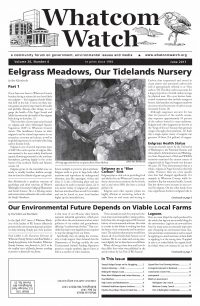by Steven D. Redman
To celebrate 26 years of publishing Whatcom Watch, we are printing excerpts from 20 years ago. The below excerpt is from the June 1997 issue of Whatcom Watch.
Editor’s Note: Steven D. Redman is author of “Visions of the Sentient Earth,” 2012; “Lifestory: An Honorable Viecaw of the Human Purpose within the Earth’s Biosphere,” 2014; “New Poems Flow From the Land,” 2016.
This essay is meant to be a scientific opinion on humanity’s ecological destruction of the Holocene world through its own population growth and industrial-economic expansion; it’s not a religious article. I’m arguing at that basic level to make my point clearly and forcefully understood. We can’t go on destroying life on earth and expect to live through it as a species. We must tune in to the ecological reality at hand. This is a glimpse into the state of things in Everson on Earth Day, 1997.
The Bible, in Genesis says that God created the Earth and all life within it, and thought that it was good. Since the Bible establishes that God is quite fond of the creation of life, and finds that it is good, then perhaps we should examine humanity’s treatment of other living things, and ecosystems in general, to see if it is good.
Does humanity value and appreciate the gift of creation within which it exists? Do ecosystems, and all creatures that depend for existence on the particular one they inhabit, have any rights in human society? If we exist as creatures dependent on the ecological integrity of the present and future world, then isn’t the value we hold for it a reflection of the value we have for ourselves? If nature has no standing in human society, in our laws and actions, then what standing do we have in the true world of nature?
Having said that, I now want to consider a particular case happening at this very time where my family lives in Everson-Nooksack, Washington, twenty miles northeast of Bellingham. And from the onset I’ll admit my bias. I have directly studied biology/ecology for half my life, fourteen years. I believe the value of every living, native ecosystem on earth to be so great that it is sacred. I tend to look at things from a scientific, ecocentric persuasion. I come from the relative wilds of northwest lower Michigan, a highly forested land, and I love nature, and I too think it is good. So I’ll stand my ground and argue from here.
Now then, there is a greenbelt in Nooksack, just north of the junction Highway 9 and Pole-Southpass Road. It lives between Highway 9 and the railroad tracks on a piece of land about 100 feet wide by a quarter mile long. It consists of mature red alder, some paper birch, cottonwood, young red cedar, a few big Douglas fir, and an understory of vine maple, Indian plum, salmonberry, ferns and wildflowers. It’s a very beautiful strip of native forest, an “upstanding” member of the community, home to many birds. It has lived there, its piece of the planet which it has glorified immensely, for fifty years or more. I always thought it was a city greenbelt. I admired its beauty, and appreciated the noise, dust, and heat/cold reduction that it provided daily. It was something that made Everson a nicer, healthier and peaceful place to live. To me it was cousin and friend, a rich and radiant microhabitat to diversify the living landscape.
Then came the day about three weeks back when through no fault or crime of its own, nor any trial in which it had a defense, the innocent, living, native forest greenbelt of Nooksack was sentenced to death in the court and land-use/real-estate laws of humanity. Just the latest, voiceless victim in humanity’s systematic, incremental and cumulative ecological holocaust against the only known living things in the universe!
I knew it was sentenced to death when real-estate signs appeared at its north and south ends proclaiming, “Commercial Lots Available,” and showing a long rectangle divided into five boxes — so simplistic. No, this stand of native forest wasn’t going to be selectively logged to provide a supply of wood products in perpetuity; it was going to be completely destroyed, paved and built over. Good-bye living ecosystem for the next millennia. Nooksack’s very own strip-mall scar, when decadent commercial sites already exist, waiting to be restored, on the other side of the road just a little to the north of the greenbelt.
A road cut here, a woodlot paved there, another dollar out of each acre every year. Life erodes away. It all comes down to human population growth overwhelming the planet’s ecological resilience. Sure we also need better planning, more ecological-sensitivity. It took fifty years for that forest to grow; where will the birds and frogs go when it’s bulldozed in a couple of days?
We need real change in human thinking. We need to grow up, quit living in a fantasy world of self-worship, by which we disgrace God, nature and ourselves, and accept the ecological reality within which we exist. That forest stand to which I refer (and all the others like it) is a living thing; it’s our friend, our cousin in life. To kill it is treachery!
We’re bad stewards. We do not honor God’s life creation. Are we stewards at all, or the proverbial fox in the henhouse? Must we be relieved of our duties, let nature rightfully take the helm? In a society of humans, where God’s creation of life on Earth has no value, no standing, no right to live, there can be no future, nor is there a purpose or foundation for its present existence? To that I say life reigns supremely forever. Amen!




























